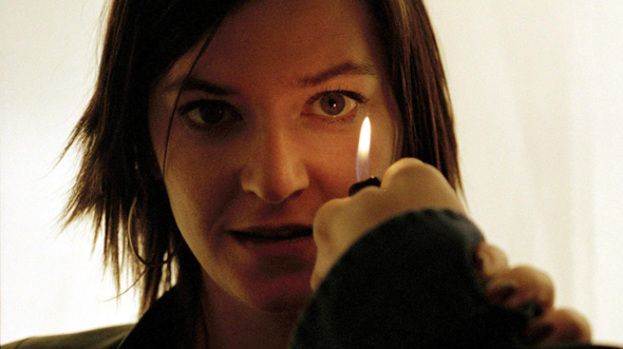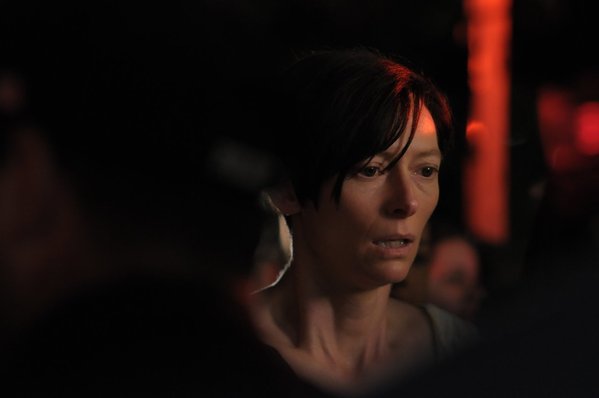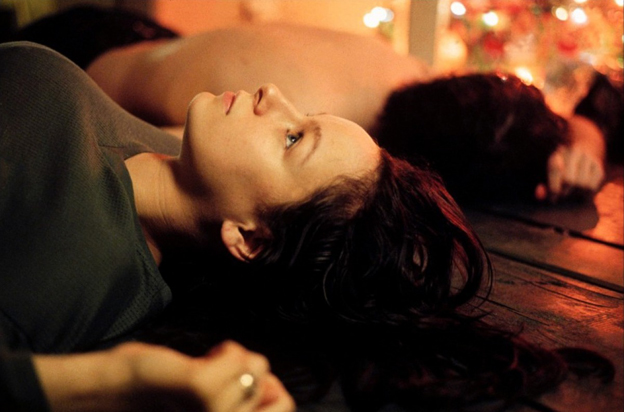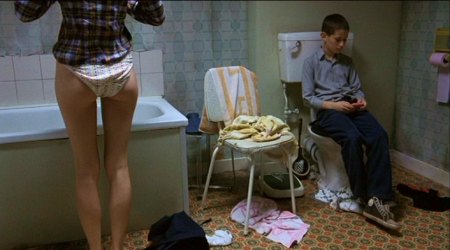Lynne Ramsay: Outsider Auteur
Denah Johnston

Though Scottish director Lynne Ramsay has been making films since her days at the United Kingdom’s National Film and Television school, she worked with still photographic images before moving pictures: her interest in photography was inspired by Maya Deren and the avant-garde of the 1940s. Making the choice to move from telling stories in a single frame to the rapid succession of frames unfolding in time requires more than just a keen eye. Ramsay has always been fond of films that surprise her – offer the unexpected, and evoke something Robert Bresson once said about being conscious when the image is doing everything that one should not feel compelled to add sound and when sound is doing everything it is not necessary to have an image. Her consciousness of and sensitivity to filmic moments in time continues to shine a very conspicuous light on an at once praised voice of cinema as well as a surprisingly neglectful attitude in terms of recognising her work in the standard industry fashion: awards. This is not to assume that the height of success can only be achieved by nominations and wins at certain award ceremonies; however it is important in the wake of Kathryn Bigelow’s directorial win in 2009 for The Hurt Locker (2008) to note that supposedly – as we are constantly reminded – the proverbial glass ceiling has been shattered. But in the years that have passed since, it is sadly ironic that the only gap that has been bridged by women in the film industry in any significant fashion has been by writers (Masters 2011).
Then again, it should come as no surprise that Ramsay has consistently been involved in the writing of the screenplays for each of her three feature film projects that have surprised and impressed audiences and critics alike: Ratcatcher (1999), Morvern Callar (2002) and We Need to Talk About Kevin (2011). Not to mention the horrid tale of her adaptation of The Lovely Bones for the screen that was swiftly derailed once Peter Jackson expressed interest in the project and the completed novel became an Oprah’s book club pick. Supposedly the lesson to learn here is do not start adapting a novel that is in the galley phase, when it is put out to pasture and completed it might turn into something predictable, wildly commercially successful and then the studio wants a ‘faithful adaptation’ with a slapped on voiceover to repackage the success of the book. In the disastrous wake of the critical and spiritual failure of The Lovely Bones one wonders what a version penned and filmed by Ramsay would look like, for her take was more interested in developing and exploring the father’s interior life – think ‘Hamlet and the ghost’. Instead, Ramsay has said that through her trials in Hollywood development “no one was telling me the truth, like 1984. They’d say ‘Yeah, we like it, but can we make it a version of Susie we know and love’” (Davis 2011). This spelled the end of Ramsay’s involvement in the project. What, then can we hold as a measure of success when a writer and director’s work is forever pushed to the periphery of the conversation?
Perhaps, not coincidentally we find that in the very title of her last film – We Need to Talk About Kevin – that a great number of articles, blogs and other public forms of protest in favor of more attention for the film, its director as well as the stellar performances therein use a handy moniker culled from the name itself (“We Need to Talk About _______________”). Of course this is an interesting case, the film was adapted by Ramsay and her husband Rory Kinnear from the best-selling novel by Lionel Shriver. Prior to this, Ramsay wrote the shorts and debut feature and adapted Morvern Callar from the novel by Alan Warner. There are a number of elements that continue to make Ramsay’s films rise to the top of many lists and essential viewing recommendations, surprisingly they all seem simple elements that should go into any film production worth its salt: thoughtful sound design, visceral cinematography, effective editing combined with somewhat taboo subject matter. In addition there is the refreshing element of a kind of modern social realism that does not defeat itself by trying too hard or cashing in on popular trends – Ramsay’s films always stay true to their characters and remarkably never compromise for the sake of high gloss, marketing ploys or other industry follies. These films are made simply because they must be: the true sign of an auteur. Not to say that audience is not important, but it is not the sole driving factor behind the development of these projects. In the work of Lynne Ramsay lies an unflinching authenticity that delves into the depths of the lives of her characters – for better or worse. For many it is this realism and authenticity that produces such strong attachments to her style and substance as a filmmaker.
In Andrew Sarris’ 1962 essay Notes on the Auteur Theory he states “the way a film looks and moves should have some relation to the way a director thinks and feels” as in a signature style exhibited over a number of films (Sarris 2004: 562). For Hollywood produced cinema it is often difficult to find an auteur, as many of the projects are commissioned or made by work for hire. For a director to: develop a project, assemble a team, secure financing and other resources and then proceed to production and post-production is indeed a rarity. The element of personal style is often absent from said work for hire directors who are brought onto a project that has already been developed and perhaps has already begun shooting under someone else’s direction. In the case of Ramsay, each of her films strikes through all three of Sarris’ concentric circles of technique, personal style and interior meaning. Ramsay’s work is not auteur in the bloated ideal of an author as God, rather it is a “tissue of quotations drawn from the innumerable centres of culture,” none of which is the original source for the text (Barthes 2011: 348). This realisation is a hybrid of the ideas of Sarris and Roland Barthes. Though a project like We Need to Talk About Kevin exposes the narrative of Kevin through Eva’s experience, a tactile sensitivity is balanced between polar opposites as in Ratcatcher, which volleys between the world seen by adolescents as well as the harsh light of unfulfilled and disappointed adulthood. Let us not forget that an auteur model views the body of a director’s work and not isolated examples: a constant flux of style and substance.
Aesthetics
Looking at any of Ramsay’s films one can tell they are hers – the fluid camera work, the silent moments lingering on frames within frames, the audience’s entry point and identification with many of her characters comes through these seemingly effortless modes of visual presentation. Her keen attention to the importance of sound design acts as a lynchpin for the very success of her films. For example, in Morvern Callar the narrative is propelled forward by a mix tape that her boyfriend made for her – the deftly mixed sound from the headphones into the mix of the soundtrack. This isimage married to sound, as David Lynch would say. Again, silence is as important to her mix as music and ambient sound: the opening sequence of Ratcatcher with Ryan twisting himself up in his mother’s lace curtain eerily notes that something is about to happen – as is the case in the opening of We Need to Talk About Kevin when the camera swiftly and slowly moves towards an open sliding glass door that causes a sheer curtain to waft in a kind of tortured tension.
There is a maliciously aligned front that has taken guard (in apparent defence) against the overt ‘artiness’ of Kevin’s flawless combination of insanely beautiful and terrifying cinematography and non-linear structure. Some have said it is a mere playbook of tricks from film school while others say it is all flash and no substance. Perhaps it shocked some critics and more outspoken audience members into such a frenzy of dislike simply because they were so upset they had nothing to do with its creation. The economic collapse perhaps ironically resulted in the budget being cut in half dropping to $4 million from $7 million when Summit Entertainment (the financing group behind the Twilight franchise) backed out of a much needed co-financing position. Ramsay was incited to be that much more creative. Now she had to shoot the film in thirty days instead of sixty, with far less resources and would need to ask the majority of her crew to sign on to the project as a labor of love. Think Dogme-like restrictions by circumstance, not by self-imposed manifesto. But this strikes close to the heart of Ramsay’s history and development as a filmmaker. In earlier works she would not haphazardly drop a pop song into the sound mix simply to move from one sequence to the next – her sound would always be motivated, at times subjective. In her early work she would cast her brother and niece in critical roles, working with them repeatedly.

Taboo
‘I thought at the time that I couldn't be horrified anymore, or wounded. I suppose that's a common conceit, that you've already been so damaged that damage itself, in its totality, makes you safe’ Lionel Shriver
Much like the French New Wave and British ‘Kitchen Sink’ films Ramsay has always had a penchant for addressing slightly taboo subject matter. Not simply because it is forbidden, but rather because these conditions continue to exist and people must deal with them. Her first three short films Kill The Day (1996), Small Deaths (1996) and Gasman (1998) take on an ex-con junkie trying to stay clean, three episodes in a girl’s life and a joyous and uncomfortable segment of quality time with an absentee father respectively. Two of these films garnered prestigious attention at Cannes. Each of these early films offer glimpses between childhood freedom and innocence and some ultimate turning point, after which life can never be seen or understood in the same way again. Ramsay’s work directing children as well as non-actors is phenomenal. Many scenes in her films that capture the ethereal nature and magic of youth appear more as if they are effortless home movie excerpts. This is not standard fare for commercial success. The relatability of these dreamlike sequences evokes the romanticism of bygone days of carefree youth, hazy soft focus and sundrenched dreams of simpler times when the future was a vast empty page.
Ratcatcher offers a number of difficult yet touching and relatable scenarios. Taking place in Glasgow of the early 1970’s when garbage men were on strike and council estates suffered the health hazard costs, Ratcatcher polarises the ‘have not’s’ – James’ family is forever waiting to hear if they are eligible for new housing, in the meantime they have no choice but to live in squalor. Complex family emotions and relationships run the gamut – stepfather and half-sisters surround our James who is troubled from the beginning when a simple game ends badly in the canal. His tender connection with lanky and equally troubled Anne Margaret and animal loving Kenny only serves to complicate things in the somewhat Darwinist social hierarchy that exists on the estate. Much of the film is spent with James walking empty streets, dreaming in newly constructed council housing, on occasion the audience is granted a fantasy sequence that alleviates the heaviness and trouble of the narrative: breaking the cardinal ‘rule of three’s’ Ramsay gives us a spare two, for this is a world in which we are lucky to get anything at all.
Morvern Callar opens a register that many would deny exists all together: what happens when your significant other commits suicide around Christmas time, leaves a note, their ATM card and a finished manuscript? Already detached Morvern Callar goes on a journey with the audience is privy to much of her internal monologue – though more through breathtaking cinematography and gesture than spoken words. It may go too far to suggest that this narrative plays with the ‘be careful what you wish for’ trope, but how can one deny this point of entry? Ramsay has spoken of her approach in this film as one of intentional voyeurism. “I think the film’s got a really sensual quality, and I wanted that to permeate through the imagery, the sound, everything. It’s one of the best qualities of the medium, and it’s just so underused, so I hope that comes across” (Leigh 2002). Of course one of the eminent dangers proved true in this effort as well: the bold and fearless nature of the film was lost on audiences that lacked a certain amount of imagination or willingness to go on a journey with Morvern wherever that might lead.

Process and Exhibition
It comes as no surprise to find that due to the lack of nominations for We Need to Talk About Kevin (save Tilda Swinton’s Golden Globe nod) that the theatrical release of the film was pushed further and further back. Considering the film premiered at Toronto in January 2011 and began its theatrical run a year later does not seem out of the ordinary. Then again, this is a film based on a novel that found smashing success in the United Kingdom and marginal interest in the United States. The disintegration and resulting dysfunctions of the mythic nuclear family has been happening for decades – evidence can be seen in very successful (i.e. arguably financially successful) films of the past ten to fifteen years: Fight Club (1999), Little Miss Sunshine (2006), The Royal Tenenbaums (2001), Winter’s Bone (2008) and American Beauty (1999) immediately spring to mind. Of course, most of these narratives (except for Winter’s Bone) center on men and their resulting issues whereas the world in We Need to Talk About Kevin is compromised by Kevin’s actions the narrative focuses on Eva and her purgatory, doing her penance in the town where the atrocity happened, exposing and hiding herself in one fell swoop. The audience must grapple with questions such as ‘is Eva a reliable narrator?’ For Eva, memory (the structure of the film itself and the [re]telling of the story) is selective and fractured at best. Then again, she is reliving the nightmare even in her sleep – forever asking the questions of ‘what went wrong?’ and ‘what could I have done to prevent this?’ The psychological horror of the film is still somehow unfathomable for most. In a culture and audience that eats up ‘torture porn’ and slasher sub-genres of horror where body parts are removed (and sometimes reassembled in all kinds of graphically detailed manners) we still can not manage to let this reflection of real life terror in enough, to hope to understand it’s reasons and conditions, let alone make any sense of the bigger picture in the aftermath.
Of course Ramsay has insisted that Kevin is not an ‘issue film’, however it certainly elicits conversations that most people do not want to have such as the nature/nurture debate, post-partum depression, infanticide, familial bonds and what happens in the wake of their absence and countless other elements everyone tries to navigate as they maneuver through life and relationships. The disconnected nature of Kevin and Eva create a dysfunctional family portrait that can be connected to the pre-eminent disconnect of Morvern Callar: where is she going? Making films with such emotional and social stigma can admittedly be an uphill battle: this is one of the many reasons it takes years to see a follow-up film from Ramsay. From the Oscilloscope press kit for Kevin: “It is always a struggle to make something with an individual voice. You need to be resilient and realistic” (2011). Funding has always been a struggle for these types of projects. While some might argue for the John Cassavetes model of financing independent films, not everyone is an actor with the clout and demand that he was fortunate to have. However, creative partnerships have always been a cornerstone of Ramsay’s process and ability to realise such projects. Among Kevin’s many Executive Producers are Tilda Swinton and Steven Soderberg, which gives one hope for the possibilities of future projects that work against the easy cash cow model for ‘success’. A similar approach to financing can be seen in Dee Rees’ Pariah (2011), another brave film that has garnered similar underdog attention this year, which was supported by a large network that includes Spike Lee, the Sundance Institute and other forces. Of course this was not an ‘easy’ film either and required much behind the scenes manoeuvring to come to fruition, not to mention the many imposed lines of division among African American and LGBT communities. Here we see evidence that a challenging film serves to further expose cracks that already exist in society.
Against the Grain
Ramsay has continued to make uncompromising films that make demands not only of the participating actors and non-actors but also of their viewers, who end up experiencing the highs and lows in the thick of it along with the main characters. Where sound design has always been an important element for creating the worlds of her films Radiohead’s Jonny Greenwood (who scored Kevin and Morvern Callar) moves in unison with its soundtrack. Ratcatcher exhibits a different approach in its period nature – dropping a needle on the record of late 60s pop music adds texture and context to fleeting moments of joy and familial celebration. If ever there was a filmmaker who does not use music to enhance a scene it is Ramsay. Music is a form of expression for her that commands respect – much like film.

In many interviews Tilda Swinton has said, “Like anyone who had seen a Lynne Ramsay film I was longing to see another one” (Kois 2012). For cinephiles, as well as serious lovers of art and music, the challenge of a work that does not simply deliver an easily digestible take-away or neatly fit into a 12 to 15-word log line the films of Ramsay are a rare treat. An eclectic mix of Andrei Tarkovsky, David Lynch, Dogme and the uncompromising spirit of William Shakespeare and Douglas Sirk’s unhappy happy endings can be seen in the periphery of her frames, as well as in her approach to filmmaking. Not mere carbon copies of her influences or associations – but a synthesis of her way of seeing the world and telling a story with the essentially visual medium of film she is always aware of the ‘show don’t tell’ maxim of successful filmmaking that so many others smile and nod about but most completely forget because they simply do not value their audience’s intelligence or experience. Though the road to this point has been rough and treacherous she rests assured that nothing will come easy – after all her current project is a psychological science fiction film that investigates Moby Dick in space. She is also slated to direct Natalie Portman and Michael Fassbinder in the female-driven western Jane Got Her Gun. As genre codifications of narrative, authorship and viewership may no longer have the clearly defined cache of days gone by Ramsay will no doubt deliver a series of timely revisionist twists challenging and superseding expectations, stretching the form to the outer limits of possibility. What better genres for Ramsay to exercise her sensibilities with than the Western and Science Fiction: traditionally American and male driven respectively. The future of Ramsay’s cinema looks complicated, dark and lovely on the horizon.
References
Barthes, R. (2011) “The Death of the Author”, in Critical Visions in Film Theory: Classic and Contemporary Readings, T. Corrigan, P. White, M. Mazaj (eds), Boston: Bedford/St. Martin’s Press, pp. 345-49.
Davis, E. (2011) “Kevin Director Lynne Ramsay Working On 2 New Projects, Trashes Peter Jackson's The Lovely Bones”, IndieWire, 16 May 2011. http://blogs.indiewire.com/theplaylist/cannes_director_lynne_ramsay_working_on_two_new_projects , accessed April 2012.
Kois, D. (2012) “Lynne Ramsay Is Back. Finally”, New York Times Magazine, 13 January 2012, http://6thfloor.blogs.nytimes.com/2012/01/13/lynne-ramsay-is-back-finally/ , accessed April 2012.
Leigh, D. (2002) “About a Girl”, The Guardian, 4 October 2002, http://www.guardian.co.uk/film/2002/oct/05/features.weekend, accessed April 2012
Masters, K. (2011) “Why the Odds Are Still Stacked Against Women in Hollywood”, The Hollywood Reporter, 9 December 2011, http://www.hollywoodreporter.com/news/angelina-jolie-kristen-stewart-emma-watson-katheryn-bigelow-269694 , accessed April 2012.
Oscilloscope (2011), We Need to Talk About Kevin, Online Press Kit, http://www.oscilloscope.net/films/film/56/We-Need-To-Talk-About-Kevin#press , accessed December 31, 2012.
Ramsay, L. (1999) Ratcatcher, UK/France, 94 mins.
Ramsay, L. (2002) Morvern Callar, UK/Canada, 97 mins
Ramsay, L. (2011) We Need to Talk About Kevin, UK/USA, 112 mins.
Sarris, A. (2004) “Notes on the Auteur Theory in 1962”, Film Theory and Criticism: Introductory Readings, L. Braudy and M. Cohen (eds), New York/Oxford UP, pp. 561-564.
Clips
Ratcatcher
(1999)
http://www.youtube.com/watch?v=hOZKbOwNGhQ
Morvern Callar
(2002)
http://www.youtube.com/watch?v=9iGONDWCnsM
We Need to Talk About Kevin
(2011)
http://www.youtube.com/watch?v=qN_VRG_5nqc&feature=relmfu